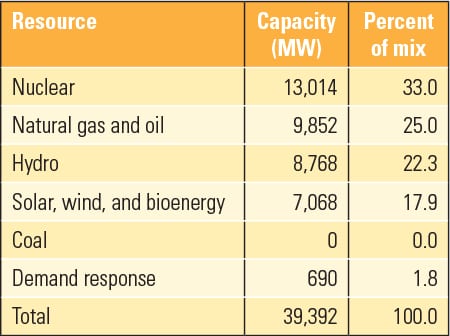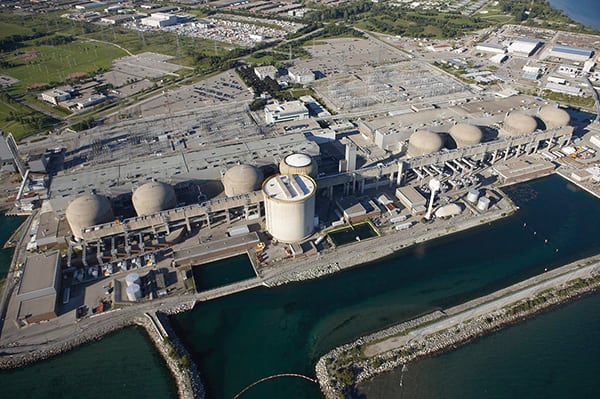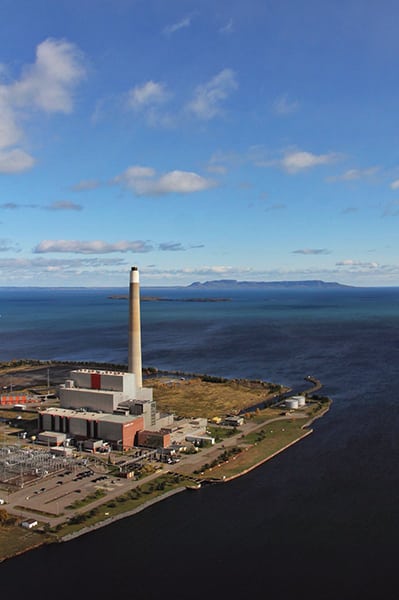Ontario Power Generation: A Clash of Politics and Power Planning
Ontario—Canada’s most populous province and its major economic engine—has an electric power supply system so driven by provincial politics that it has pushed the province’s utility generating arm, Ontario Power Generation, into what appear to be incoherent resource policies.
Late last September, in a stunning announcement, the Canadian province of Ontario’s Energy Ministry said it would “immediately suspend” procurement of over 1,000 MW of previously selected renewable energy projects—mostly wind—to save some C$3.8 billion (US$2.91 billion). Driving the decision were soaring retail electric rates in Canada’s largest and most important jurisdiction, jeopardizing the political prospects of Ontario’s ruling Liberal Party.
The procurement was the second phase of an aggressive renewables acquisition, on top of substantial existing renewable generation. The first phase of the new initiative, for 500 MW, has yet to be implemented. The province potentially could be dumping some 1,500 MW of new renewables. Shawn-Patrick Stensil, a provincial Greenpeace activist, said that the Liberal government of Premier Kathleen Wynne “just threw renewables under the bus.”
Consumers Foot the Bill
Nearly a month before the government’s decision to kill its 1,000-MW renewable acquisition, Jon Kieran, a solar energy lobbyist and long-time energy executive, urged cancellation. He wrote in the National Post, “Intrusive policy and poor implementation are largely responsible for the energy market debacle Ontarians face today. But there is no excuse now for buying more mega-projects when our power supply is saturated and hydro [electricity] bills are skyrocketing. Coal-fired power generation effectively disappeared after 2010, by which time Ontario’s electricity demand had already started to plummet. Demand has fallen 13 percent in the past 10 years, including consecutive reductions in each of the past five years. In 2016, Ontario will consume less electricity than in 1997.”
The decision came as Ontario consumers were complaining loudly about electric rates, which saw a 12% rise in 2015, according to analyst Bruce Sharp. Soaring electric rates ignited a political firestorm in Ontario. The National Post newspaper reported, “Half of Ontario voters feel unprotected from price increases in the electricity system.” A headline at the time of the announcement of the renewables dump said: “‘Ontarians have never been this angry’: Poll respondents feel unprotected from power price increases.”
The rate shock has deep roots: the province’s decision some 15 years ago to shut down its coal generation; a political and economic fiasco over replacement gas-fired capacity; and the procurement of high-cost renewable capacity with take-or-pay contracts. At the same time, Ontario Power Generation (OPG), the province-owned electric generating utility, was committed to shutting down significant capacity at its six-unit, 3,100-MW Pickering nuclear plant (with plans to shut the plant entirely by 2018, although there is now talk of extending operation into 2024) and to spending some $12.8 billion to refurbish the four-unit, 3,500-MW Darlington nuclear station (Figure 1).
Incidentally, a third Ontario nuclear station—the eight-unit, 7,500-MW Bruce plant—was built by OPG’s predecessor, Ontario Hydro, in the 1970s and 1980s. It underwent an extensive revitalization project of its own, leading to a POWER Top Plant Award (see “Bruce Nuclear Generating Station, Kincardine, Ontario, Canada” in the November 2013 issue). OPG sold Bruce in 2001 to a private consortium, Bruce Power, with a contract to sell the power back to OPG through 2018.
Politicians Pull the Strings
A striking element in the Ontario story is that OPG appears to have had little or no impact on the power production decisions of the province, following a turn-of-the-century restructuring that broke up the former integrated utility Ontario Hydro into five entities, including OPG. The generating utility now seems to serve more as a staff organization implementing the political decisions of the governing Liberal Party, and less as an expert advocate for the province’s energy and capacity needs.
The government’s press release announcing the abandonment of the renewables procurement made no mention of OPG; instead, it said that the Energy Ministry would “begin this fall with consumers, businesses, energy stakeholders and indigenous partners regarding the development of a new Long-Term Energy Plan, which is scheduled to be released in 2017.”
Energy Minister Glenn Thibeault told the National Post after the decision to scrap the next round of renewables, “It was power that we didn’t need right now. Looking at this prudently and finding ways to continue to have downward pressure on rates, because that’s one of the mandates that I’ve been given by the premier, I acted on it.”
Thibeault said the decision to cancel the 1,000 MW “would save the typical residential electricity consumer an average of approximately $2.45 [monthly] on his electricity bill, relative to previous forecasts.” The opposition Progressive Conservatives (the Tories) crowed at the decision, as Ontario has been selling excess power at low prices to the U.S. Tory leader Patrick Brown said, “This government has plowed ahead for years signing contracts for energy we simply do not need. The premier has become the best minister of economic development that Pennsylvania and New York [have] ever seen.”
Tom Adams, a long-time observer and critic of Ontario energy policy (and a Tory supporter who is also skeptical of that party’s electricity policies), told POWER, “The political science version of the Ontario story is this. Everything in Ontario’s electricity system has been transitioning over a period of almost 15 years, mostly since 2002, when OPG became a direct ward of the state. It is directly controlled by the Energy Minister’s office and micromanaged to an unbelievable degree.” As a result, said Adams, “We are up to our eyeballs in base load, which is under-utilized and losing money.”
Adams said OPG employs many excellent electricity experts, who know their jobs and are dedicated to providing the province with a mix of generating resources that protects the environment and minimizes consumer costs. But, he concluded, the politicization of Ontario’s electricity system at the hands of the Liberals makes their jobs impossible.
One of the most scathing critics of the province’s electricity policy is Ontario’s Society of Professional Engineers. The National Post reported that the engineering group “has issued more than half a dozen critical reports on the Liberals’ tendency to let green talk and politics override sound policy. Instead of following the expert advice of engineers and people who understand the intricacies of electricity production and distribution, the government took to issuing directives right out the premier’s office.”
While initially agreeing to participate in the research for this article, OPG failed to follow up, repeatedly refusing to respond to POWER’s requests for comment. First offering an interview with renewables chief Mike Martelli, OPG broke off communication shortly before the announcement of the decision to kill the renewables purchases. The Energy Ministry failed to respond to requests for interviews and comments.
A Longstanding Capacity Glut
Another long-time critic of Ontario’s electricity policies, Financial Post columnist Terence Corcoran, commented on the government’s renewable retreat: “One should never underestimate the ability of politicians to convert massive policy failure into a dazzling display of green concern for the welfare of voters. That’s the trick now being attempted by the Liberal government of Ontario as it begins to unravel parts of its financially disastrous green energy program.”
Corcoran wrote that the aim of the provincial government “is to keep consumers and the public in the dark over the electricity mess that exists after a decade of Liberal policy based on the slogan ‘Renewable is doable.’ In the rush to green, Ontario’s electricity sector has become an overbuilt collection of electricity-producing assets selling power at high prices into a declining market. Since 2006, annual electricity demand within Ontario has dropped 6.5 percent, mostly a function of declining industrial sectors. Meanwhile, installed capacity soared by more than 25 percent, mostly a function of the government’s expensive wind and solar schemes.”
OPG, the province’s dominant electric generator, is best known for the phase-out, beginning more than a decade ago, of all coal generation in Ontario, a political goal favored by both of the dominant parties at the time. April 2014 saw coal’s finale with the conversion of the small Thunder Bay plant to fire on biomass (see sidebar “The Strange Case of Thunder Bay”). The province has gone from 25% coal-fired generation to 0% (see “Ontario Goes Coal-Free in a Decade” in the May 2013 issue of POWER).
OPG was able to kill coal over a decade, according to Adams, because the province has long had a large surplus of baseload generating capacity. The death of coal had no impact on reliability. After lopping off its substantial coal generating assets, Ontario’s peak electricity demand in 2015 was about 24 GW, while the system’s generating capacity was in excess of 39 GW (Table 1).
 |
|
Table 1. Ontario’s 2015 installed power generation supply mix. Source: Independent Electricity System Operator |
The transition from coal led to a failed move to gas, a costly program to upgrade nuclear and hydro capacity, and the most recent, interrupted move to more intermittent renewables. That series of events led to soaring electricity bills and a revolt among the province’s retail consumers.
The Huffington Post Canada reported this summer that “Ontarians have seen two rate hikes since December, adding around $100 to the average annual hydro bill. The problem is especially acute in rural Ontario, where high delivery charges mean some families are paying in the range of $300 a month for electricity. Manufacturers complain that soaring electricity prices are forcing production out of Ontario and giving Mexico and other countries a competitive advantage.”
Ontario’s politically driven electricity policy began in earnest in 2003, with the advent of the Liberal Party government of then-Premier Dalton McGuinty. It has continued with his successor, Kathleen Wynne. McGuinty’s edict to close the province’s coal generation was the crux of his plan to reduce Ontario’s greenhouse gas emissions; it was also a political move to solidify his support in the province. The left-wing New Democratic Party (NDP) was pushing to shut down coal generation by 2007. The Tories were offering a 2015 shutdown. Although McGuinty adopted the 2007 date, the phase-out wasn’t complete until 2014, closer to the Tories’ timetable.
The Gas Fiasco
Killing coal was relatively easy. Ontario’s electric generating system, with excess capacity, particularly nuclear and hydro, absorbed the lost coal capacity without reliability impacts. However, it did drive retail rates up by taking the least-cost generation out of the dispatch queue.
In response to the end of coal, the McGuinty government launched an aggressive move to natural gas. That failed adventure spelled the end of Dalton McGuinty’s political career, although not the end of his party’s control of the Ontario government.
Recognizing that closing coal capacity could challenge reliability, the McGuinty government began acquiring new natural gas combined cycle generation. It awarded a contract in 2005 for a 280-MW combined cycle project in the city of Mississauga and in 2009 for a 900-MW combined cycle plant in Oakville.
Both proposals yielded intense local opposition. Opponents rallied October 1, 2010, at the Ontario Legislature, with the featured speaker U.S. environmental activist Erin Brockovich. In the 2011 provincial election, all three Liberal candidates for Mississauga’s seats (Mississauga is the sixth-largest city in Canada, with a population of about 713,000) opposed the power plant and won election. In Oakville, TransCanada Energy (TCE), the project developer and a natural gas pipeline company, was unable to get preconstruction approval from the city government. On October 7, 2010, the McGuinty government cancelled the Oakville plant, stating that TCE would be made “whole” and was entitled to damages and the full worth of the contract.
On September 28, 2011, ahead of the general election, the Liberal Party said that if it won the election, it would cancel the Mississauga project. Liberals won the most seats on October 6, 2011, but fell one short of a majority. That opened the way for the opposition to use legislative committees to launch examinations of the gas plants fiasco. The next day the Energy Ministry announced that the Mississauga project was dead.
McGuinty’s staff was negotiating with TCE over the Oakville cancellation throughout this period, offering TCE a $462 million settlement. TCE rejected the offer. A month later, McGuinty upped the proposal to $712 million, but TCE still said no.
As negotiations were under way, a legislative committee ordered the government to turn over “all correspondence, in any form, electronic or otherwise, that occurred between September 1, 2010 and December 31, 2011” related to the cancellation of the Oakville and Mississauga plants. In August 2012, then-Energy Minister Chris Bentley announced a settlement with TCE, insisting that the Oakville cancellation would cost $40 million.
On October 15, 2012, McGuinty announced he would step down as premier as soon as the Liberals picked a new leader. He also “prorogued” the legislature, a procedure that put its activity on hold, effectively shutting down the investigations of the gas deals. McGuinty insisted that the cost of cancelling Oakville would be $40 million and Mississauga would cost $190 million, for a total of $230 million. He specifically rejected an estimate by Tom Adams that the cost would be over $1 billion. A year later, Ontario’s auditor general found that the Oakville cancellation would put the province on the hook for $675 million and Mississauga for $275 million, a total of $1.04 billion.
Ontario’s Liberals elected Kathleen Wynne as their leader in January 2013 and she became premier in February. McGuinty resigned his seat in the legislature in June and was soon appointed as a senior fellow at Harvard’s Weatherhead Center for International Affairs.
As the McGuinty end game was playing out in the fall of 2012, the Energy Ministry turned over some 36,000 pages of documents related to the gas plants to the legislature. Two weeks later, another 20,000 pages turned up. Later, after Wynne became premier, the legislature went back into session and the committee investigating the gas deal unearthed a third batch of documents. Charges flew back and forth about erased hard drives, withheld documents originating from McGuinty’s political staff, and the usual claims that accompany such highly political battles. Ultimately, the investigations ended inconclusively, but having done serious damage to the Liberals.
Wynne’s decision to kill the second round of the large renewables acquisition has not helped the reputation of the Liberals and Wynne. The next general election is scheduled for October 4, 2018. The Liberals have lost the last three by-elections—elections held to fill vacant seats in the provincial legislature. Recent polling shows the Progressive Conservatives with a chance at a majority. The National Post reported, just before the renewables cancellation, “The Liberals are trailing the Progressive Conservatives by 14 percentage points in the latest Mainstreet Research poll for Postmedia. The Tories—at 35 per cent—are in possible majority territory. The Liberals trail with 21 percent, followed by the NDP at 18 percent and the Green party at five percent.”
The poll suggests that the Liberals would do better with Wynne off the ticket. Quito Maggi, Mainstreet chief executive, said, “The Liberal brand in Ontario is still very, very strong, but (Wynne’s) own personal brand—she’s wearing all the negatives” of the long Liberal era.
The Tasks Ahead
In the meantime, OPG faces big-ticket, high-profile work shutting down the remaining six reactors (two others are already shut) at the Pickering nuclear station (Figure 3) and refurbishing the calandria and pressure tubes at the four Darlington CANDU reactors. OPG estimates that the Darlington work will cost $12.8 billion and yield $14.9 billion in economic benefits. Adams is skeptical, given the experience with attempted, and failed, refurbishments at Pickering, which resulted in shutting down two units. “Take the estimate and double it,” he told POWER.
 |
|
3. Continuing operation? Pickering Units 1–4 entered service in 1971 (although Units 2 and 3 have been shut down since 1997) and Units 5–8 began operation in 1983. OPG has said it would like to keep all six operating units in service at least until 2022. Courtesy: OPG |
The Ontario Clean Air Alliance said OPG has asked the Ontario Energy Board for a nuclear power price increase of 11% a year over the next 10 years, from 5.9¢/kWh in 2016 to 16.8¢/kWh in 2026, although OPG has not confirmed that report. The Manitoulin Expositor newspaper commented, “OPG’s proposed price increases are based on the assumption that its $12.8 billion Darlington re-build project will be completed on time and on budget. Of course, every nuclear project in Ontario’s history has been massively over budget, on average by 2.5 times.”
Prior to its reorganization at the end of the last century, Ontario Hydro was one of the world’s largest integrated electric utilities, highly regarded among its peers in the worldwide utility industry. The current woes are largely the result of decisions made elsewhere in Toronto than in the OPG headquarters. Said critic Tom Adams, “OPG doesn’t bear any blame for the stupid capex [capital expenditure] decisions. My sense is that within the constraints they operate under, the organization is run pretty sharply. There’s not a pack of dummies over there. Plant utilization factors are pretty impressive, particularly when you take into account the age of the assets.”
The problem with electricity generation in Ontario, Adams told POWER, is that the Energy Ministry is “larded up with a bunch of Liberal hacks” who know little about the intricacies of electricity production but don’t value OPG’s expertise.
 |
|
4. More hydro. OPG is partnering with Coral Rapids Power (wholly owned by the Taykwa Tagamou Nation) on a $300 million project to construct the two-unit 28-MW Peter Sutherland Sr. Generating Station located about 55 miles north of Smooth Rock Falls. Courtesy: OPG |
Would a Tory takeover of the provincial government change that? Adams is doubtful. “Politicians all feel urgent needs to have opinions on every element of the power system,” he said. The Tories, he added, “have prominent elected members whose solution is to build more hydro [Figure 4], which is stupid on a remarkable scale. Change in government is unlikely to make things much better.” ■
—Kennedy Maize is a long-time energy journalist and frequent contributor to POWER.

